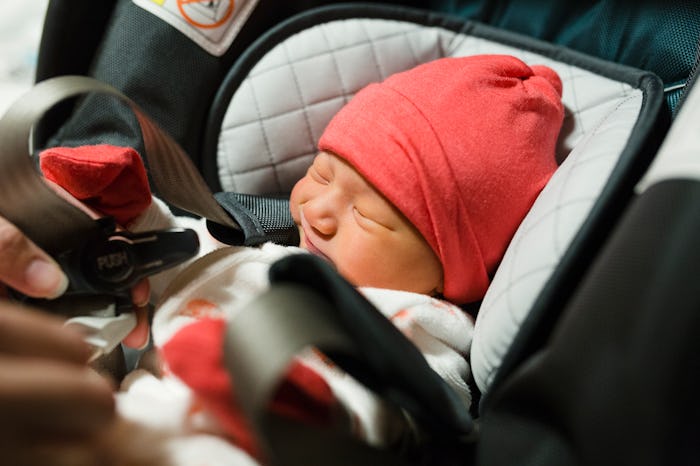Birth

Car Seat Requirements To Leave The Hospital With Your Newborn: What You Need To Know
You can’t be too careful.
Transporting your child is something that new parents will become very familiar with. From school car pools, to dance lessons, to soccer practices, to teaching them how to drive for the first time — parents spend a lot of time with their children in a car. But the first step in all of this is transporting their newborn home from the hospital. Before parents even get to the hospital, they will have to have a car seat, because hospital car seat requirements are simple: have one properly installed before you go home, so your baby can leave safely.
While it may seem like common sense to have a car seat installed, there is a whole new world of things for new parents to learn and remember (including hospital car seat requirements). And car seats are an entirely new concept for most new parents to get used to, which they will have to use for more several years after their baby is born.
What does the law say about car seats?
State laws vary — find yours here — but every state requires that all babies to be in a car seat when they leave the hospital and kids should be in a car seat or booster seat until they are around 11 years old, according to the Governors Highway Safety Association. As for newborns, the American Academy of Pediatrics (AAP) states that all infants should ride in a rear-facing car seat or rear-facing convertible car seat only from the moment they leave the hospital until they're at least 2 years old. Then there are the hospital’s car seat requirements to take into consideration.
What are the car seat requirements for most hospitals?
Parents will want to call the hospital they're planning on having their baby at to make sure they meet all of its specific requirements (the rules for each hospital can vary). This way, there won’t be any problems at discharge.
When it comes to hospital car seat requirements, safety is absolutely crucial. Before you’re allowed to leave, most hospitals require parents to bring your infant car seat into your hospital room where the nurse can inspect the car seat to make sure it’s up to date and also help parents learn how to buckle their babies in properly. “We have to make sure the car seat isn’t expired and isn’t missing any straps or other parts,” Pam Bruschi, Clinical Coordinator of the Maternal Child Unit at Greenwich Hospital, tells Romper. Some hospitals will even require babies to pass a car seat test, where they leave baby in the car seat for a specific amount of time and make sure their breathing is not compromised in that position.
Before a newborn is discharged from the hospital, parents should be trained on positioning and use of the car seat. And perhaps the most important thing is the installation of the car seat and that the car seat isn’t expired, which typically happens after six years from the date it was manufactured. Indeed, picking the right car seat is a very important step.
What kind of car seat is required?
Newborns should be in a rear-facing, five-point harness infant car seat or convertible car seat that is newborn-compatible.
We at Romper only include products that have been independently selected by our editors. We may receive a portion of sales if you purchase a product through a link in this article.
How do you install a car seat properly?
If parents are still nervous about taking their newborn home for the first time, they can ask someone to help them. Many hospitals, fire departments, and police departments offer car seat inspections and car seat installations so parents can guarantee that their kid is safe. This helpful tool from the National Highway Traffic Safety Administration can help parents locate the nearest place that will install your car seat and teach you how to use it, free of charge. This could be a lifesaver — for both parents and their newborn baby.
There are also many helpful videos on YouTube that will teach you how to install a car seat before your newborn arrives, such as this one below:
While proper installation is key, the position of the baby in their car seat is important as well. A study conducted by the American Academy of Pediatrics (AAP) found that “virtually all new parents” are using car seats the wrong way, whether they’re putting the chest clip in the wrong place or not pulling the straps tight enough, etc. That’s why you can never be too sure about checking their infant's car seat before heading out to the hospital. And when in doubt, call your hospital ahead of time to make sure your rear-facing car seat meets its requirements and go a step further and have your installation triple-checked for absolute peace of mind for driving with your very precious cargo.
Study referenced:
Hoffman BD, Gallardo AR, Carlson KF. Unsafe from the start: serious misuse of car safety seats at newborn discharge. Journal of Pediatrics, April 2016, https://pubmed.ncbi.nlm.nih.gov/26707620/
Source:
Pam Bruschi, Clinical Coordinator of the Maternal Child Unit at Greenwich Hospital
This article was originally published on